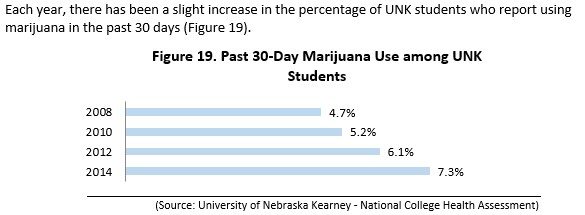The “High Impact Prevention Services” strategic direction’s focus is to highlight the importance of increasing prevention efforts and improving access to treatment for substance abuse and co-occurring disorders, as well as education and early diagnosis of Alzhiemer’s disease and dementia.
In 2005, an estimated 22 million Americans struggled with a drug or alcohol problem. Almost 95 percent of people with substance use problems are considered unaware of their problem.* Of those who recognize their problem, 273,000 have made an unsuccessful effort to obtain treatment.
Substance abuse has a major impact on individuals, families, and communities. The effects of substance abuse are cumulative, significantly contributing to costly social, physical, mental, and public health problems.
Social attitudes and political and legal responses to the consumption of alcohol and illicit drugs make substance abuse one of the most complex public health issues. In addition to the considerable health implications, substance abuse has been a flash-point in the criminal justice system and a major focal point in discussions about social values: people argue over whether substance abuse is a disease with genetic and biological foundations or a matter of personal choice.
Advances in research have led to the development of evidence-based strategies to effectively address substance abuse.
Improvements in brain-imaging technologies and the development of medications that assist in treatment have gradually shifted the research community’s perspective on substance abuse. There is now a deeper understanding of substance abuse as a disorder that develops in adolescence and, for some individuals, will develop into a chronic illness that will require lifelong monitoring and care.
Improved evaluation of community-level prevention has enhanced researchers’ understanding of environmental and social factors that contribute to the initiation and abuse of alcohol and illicit drugs, leading to a more sophisticated understanding of how to implement evidence-based strategies in specific social and cultural settings.
A stronger emphasis on evaluation has expanded evidence-based practices for drug and alcohol treatment. Improvements have focused on the development of better clinical interventions through research and increasing the skills and qualifications of treatment providers.
Military operations in Iraq and Afghanistan have placed a great strain on military personnel and their families. This strain can lead to family disintegration, mental health disorders, and even suicide. Data from the Substance Abuse and Mental Health Services Administration (SAMSHA) National Survey on Drug Use and Health indicate that from 2004 to 2006, 7.1 percent of veterans (an estimated 1.8 million people) had a substance use disorder in the past year.
In addition, as the Federal Government begins to implement health reform legislation, it will focus attention on providing services for individuals with mental illness and substance use disorders, including new opportunities for access to and coverage of treatment and prevention services.
Dementia is the loss of cognitive functioning—thinking, remembering, and reasoning—to such an extent that it interferes with a person’s daily life. Dementia is not a disease itself, but rather a set of symptoms. Memory loss is a common symptom of dementia, although memory loss by itself does not mean a person has dementia. Alzheimer’s disease is the most common cause of dementia, accounting for the majority of all diagnosed cases.
Diagnosis of dementia is key to effective treatment and care. It is important to distinguish dementia from temporary, reversible conditions that may cause loss of cognitive functioning.
“In 2013, Alzheimer’s disease was the 6th leading cause of death, for all ages, based on death certificate data. Estimates vary, but analysis of data from the Health and Retirement Study estimated that the prevalence of dementia among people older than 70 years of age in the United States in 2010 was 14.7%. In 2010, the direct and indirect costs of dementia among those aged 70 years and older totaled an estimated $159 billion to $215 billion (depending upon the monetary value placed on informal care).” INFORMATION FROM: https://www.healthypeople.gov/2020/topics-objectives/topic/dementias-including-alzheimers-disease
People living with dementia are at greater risk for general disability and experience frequent injury from falls. Older adults with dementia are 3 times more likely to have preventable hospitalizations. As their dementia worsens, people need more health services and, oftentimes, long-term care. Many individuals requiring long-term care experience major personal and financial challenges that affect their families, their caregivers, and society.
Several factors determine the risk of developing dementia, including age and family history. Other factors affect the management of dementia by families, communities, and the health care system.
Among adults aged 65 years and older, the prevalence of Alzheimer’s disease doubles every 5 years
However, during 2009 and 2010, international teams studying the genetics of Alzheimer’s disease have identified and confirmed 3 new genes that are associated with increased risk of late-onset Alzheimer’s disease.
Many individuals with Alzheimer’s disease or other dementia are undiagnosed. Primary care providers do not routinely test for Alzheimer’s disease. Alzheimer’s disease and other dementias are more often undiagnosed in rural and minority populations than in urban or white populations.
Some chronic conditions are common in people with Alzheimer’s disease and other dementias. Dementias can greatly complicate the medical management of these conditions; this increases the need for coordination of care among different specialists.
Lack of diagnosis seriously reduces a person’s access to available treatments and valuable information. Active medical management, information and support, and coordination of medical and community services have been shown to improve quality and outcomes of care for people with dementia.
Information From: https://www.healthypeople.gov/2020/topics-objectives/topic/substance-abuse
The 2020 well‐being measures (and objectives) for “High Impact Prevention Services” are listed below.
Increase the number of youth reporting they are NOT sexually active
Decrease the number of youth reporting drinking in the past 30 days
Decrease the number of youth reporting binge drinking in the past 30 days
Decrease the number of adults reporting binge drinking
Decrease the number of youth reporting smoking in the past 30 days
Decrease the number of youth reporting using marijuana in the past 30 days
Decrease the number of young adults reporting using marijuana in the past 30 days
The coalitions that are working toward improving the High Impact Prevention Services well-being measures are:
- Positive Pressure
- Responsible Beverage Server Coalition
- Community Coalition to Improve Alzheimer’s/Dementia Health







